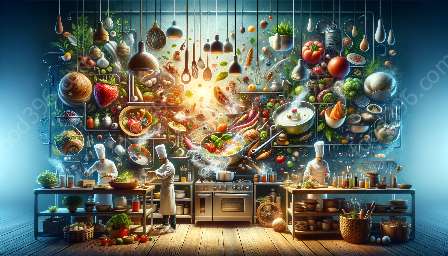Food safety and sanitation are essential components of culinary nutrition and dietetics. In the culinary arts, understanding these principles is crucial to maintaining a safe and healthy food environment. This topic cluster aims to explore the guidelines, best practices, and tips for ensuring food safety and sanitation in the context of culinary nutrition and dietetics.
The Importance of Food Safety and Sanitation
Food safety and sanitation play a critical role in the culinary arts. With the increasing emphasis on healthy eating and nutrition, it is important to ensure that the food prepared and served is safe for consumption. This not only protects consumers from foodborne illnesses but also upholds the reputation of culinary establishments and promotes trust among customers.
Key Principles of Food Safety
There are several key principles of food safety that are essential to understand in the context of culinary nutrition:
- Personal Hygiene: Proper personal hygiene, including handwashing and wearing clean uniforms, is crucial to prevent the spread of harmful bacteria and contaminants.
- Food Handling and Storage: Proper handling and storage of food, including temperature control and avoiding cross-contamination, are imperative to prevent foodborne illnesses.
- Cleaning and Sanitization: Regular cleaning and sanitization of kitchen equipment, utensils, and surfaces are essential to maintain a hygienic food preparation environment.
- Traceability and Labeling: Proper labeling and traceability of ingredients and food products help to ensure their safety and minimize the risk of allergen contamination.
Guidelines for Maintaining Food Safety and Sanitation
Here are some important guidelines for maintaining food safety and sanitation in culinary nutrition and dietetics:
- Adherence to Regulations: Culinary professionals should be aware of and comply with local, state, and federal regulations related to food safety and sanitation.
- Training and Education: Ongoing training and education for culinary staff on food safety best practices and principles are essential for maintaining a safe food environment.
- Hazard Analysis and Critical Control Points (HACCP): Implementing a HACCP system helps to identify and control potential hazards in food production and preparation.
- Regular Inspections and Audits: Regular inspections and audits of the kitchen and food preparation areas are important for identifying and addressing any potential issues related to food safety and sanitation.
- Focus on Fresh Ingredients: Utilizing fresh, high-quality ingredients can help minimize the risk of contamination and enhance the nutritional value of dishes.
- Proper Cooking Techniques: Ensuring that food is cooked to the appropriate temperature and using proper cooking techniques helps to eliminate harmful bacteria and ensure food safety.
- Allergen Management: Managing and accommodating allergens effectively is essential in culinary nutrition and dietetics, and proper labeling and communication are critical.
- Collaboration with Dietitians: Collaboration with dietitians can provide valuable insights into creating nutritionally balanced and safe food offerings.
- Clear Communication: Clear communication of food safety protocols and expectations with all staff members is essential for creating a cohesive and responsible team.
- Continuous Improvement: Encouraging a mindset of continuous improvement when it comes to food safety and sanitation practices helps to adapt to evolving challenges and standards.
- Embracing Innovation: Embracing innovative technologies and practices that enhance food safety and sanitation can contribute to a proactive approach towards maintaining a safe food environment.
Best Practices for Culinary Nutrition and Dietetics
When it comes to culinary nutrition and dietetics, incorporating best practices for food safety and sanitation is crucial. Here are some best practices to consider:
Fostering a Culture of Food Safety
To promote a culture of food safety in culinary nutrition and dietetics, it is important to instill the following practices:
Conclusion
Food safety and sanitation are integral components of culinary nutrition and dietetics. By understanding the importance of these principles, adhering to guidelines, implementing best practices, and fostering a culture of food safety, culinary professionals can create a healthy and safe food environment that aligns with the principles of culinary arts. Embracing food safety and sanitation not only enhances the overall dining experience but also promotes the well-being and satisfaction of customers.

